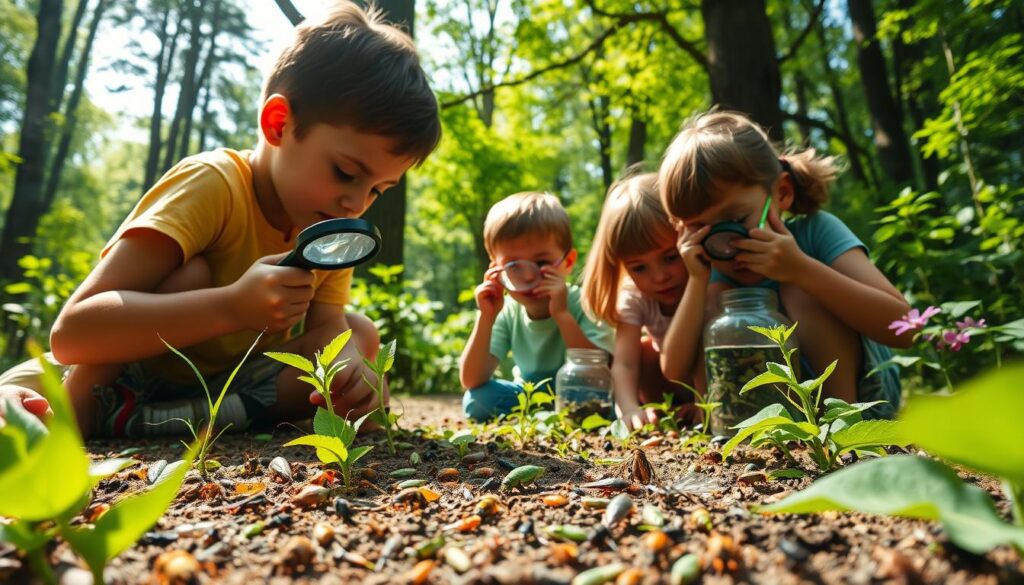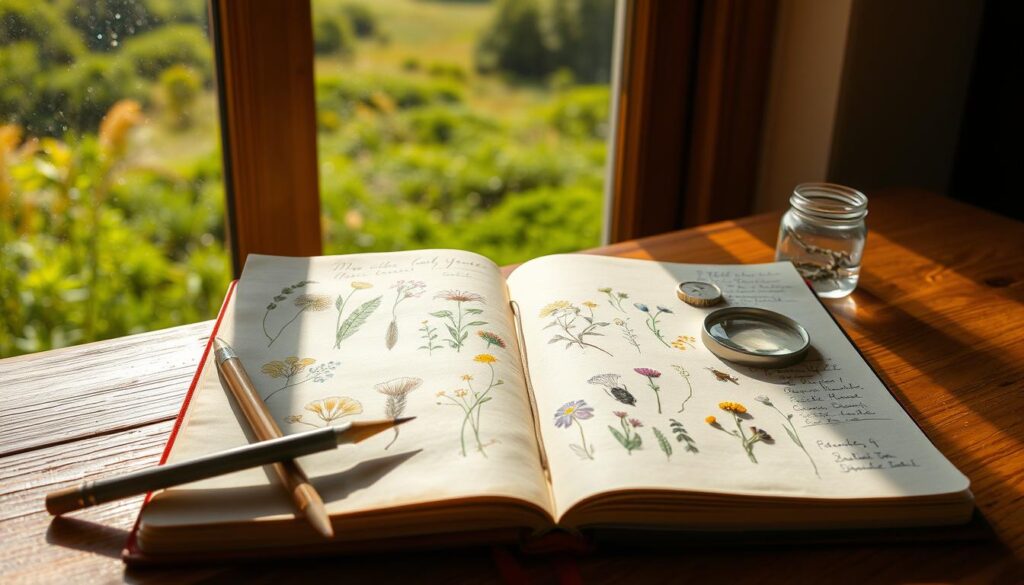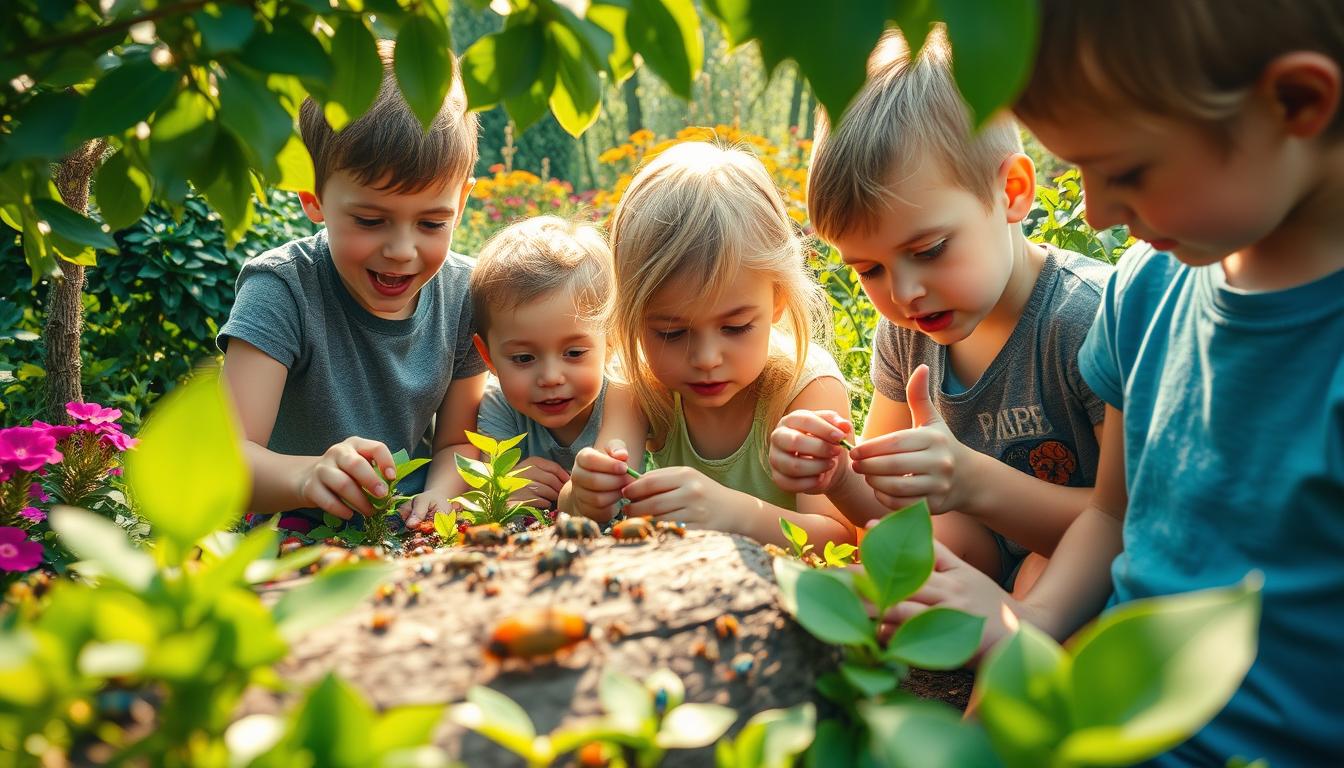Bug and Nature Exploration: An Exciting Adventure
Six-year-old Mia crouched in her backyard, her eyes locked on a red-and-black spotted ladybug crawling across a leaf. “Mom, look—it’s doing gymnastics!” she whispered, her voice bubbling with excitement. In that moment, a simple afternoon transformed into a thrilling quest to uncover more tiny neighbors living in the grass and trees.
Outdoor adventures like Mia’s spark curiosity about the living world. From beetles to butterflies, small creatures offer big lessons. These hands-on experiences teach kids to observe details, like how spiders spin silk or why ants march in lines. They also learn that arthropods—animals with jointed legs and protective shells—aren’t scary but fascinating.
Exploring outdoors builds more than science skills. Children practice patience while waiting for a pill bug to uncurl. They collaborate, sharing magnifying glasses and comparing discoveries. Creative play blossoms too, as sticks become bridges for roly-polies and dirt transforms into miniature habitats.
Key Takeaways
- Outdoor activities turn everyday spaces into classrooms, nurturing curiosity about local ecosystems
- Arthropods like insects and spiders have unique traits, such as exoskeletons, perfect for scientific observation
- Nature-based learning supports cognitive, social, and emotional growth in young explorers
- Positive adult reactions shape how kids view creatures—encourage wonder instead of fear
- Adventures outdoors create lasting memories while teaching problem-solving and critical thinking
Preparing for a Bug and Nature Exploration Adventure

Equipping kids with simple gear unlocks hidden worlds beneath leaves and logs. The right materials transform ordinary outdoor time into structured learning activity, blending play with scientific discovery.
Gathering Essential Materials
Start with clear jars for temporary insect viewing—transparent containers let children examine legs and wings up close. Add magnifiers to highlight details like a beetle’s iridescent shell. A 34-piece desktop greenhouse kit works wonders, combining tiny shovels with plant pods for habitat experiments.
Pack discovery bags with kid-sized tools: nets for aerial catches, notebooks for sketching patterns, and cameras to document finds. “Field guides turn guessing games into fact-finding missions,” says educator Lisa Porter. Choose visual books with large photos to help match backyard specimens.
Ensuring Safety and Supervision
Plastic tweezers prevent pinched fingers during close encounters. Offer gloves for hesitant explorers and shallow containers to avoid overwhelming crawlers. Always set timers—20-minute observation windows teach respect while keeping creatures stress-free.
Adapt tools for diverse needs: raised garden beds allow wheelchair access, and textured handles aid grip strength. Remember, excited shouts scare subjects more than gentle hands! With these preparations, families create safe spaces for curiosity to thrive.
Exploring Insect Habitats and Backyard Discoveries

Backyards transform into living laboratories when young explorers begin their hunt for six-legged neighbors. Start by scanning areas where tiny residents thrive—damp soil, decaying wood, and leafy hideouts offer prime viewing opportunities.
Locating Bugs in Local Natural Spots
Flip flat stones carefully to reveal pill bugs rolling into balls. Peel back loose tree bark to expose marching ant trails. Shake flowering bushes over a white sheet to spot camouflaged aphids and beetles. Microhabitats exist everywhere:
| Location | Common Insects | Best Time |
|---|---|---|
| Under Rocks | Ground beetles | Morning |
| Tree Bark | Bark spiders | Afternoon |
| Leaf Piles | Roly-polies | Evening |
Let children lead the search—their fresh perspective often spots movement adults miss. “Kids notice flickering wings or wiggling antennae first,” notes entomologist Dr. Ellen Cho. Provide nets for aerial hunts but keep jars handy for temporary observation.
Observing Insect Behaviors Up Close
Watch ladybugs fold wings like origami masters. Time how long ants transport food crumbs. Note which flowers attract hungry butterflies. Gentle handling teaches respect—show how to let crawlers walk across open palms before returning them home.
Compare how different species react to light changes or sudden shadows. These moments spark questions about survival strategies. Through patient watching, children grasp how each creature contributes to the backyard ecosystem.
Engaging Children Through Hands-On Bug and Nature Exploration

Curious hands reach for twitching antennae as young learners huddle around a discovery jar. This tactile approach turns fleeting interest into lasting fascination, blending play with scientific discovery. Simple tools become gateways to understanding life cycles and ecosystems.
Using Bug Catchers, Nets, and Viewing Jars
Show kids how to angle nets sideways for swooping catches. Demonstrate bug vacuums by pressing the hard tube near ants—“Watch them ride the air elevator!” whispers teacher Marco Torres. Let children practice brushing insects into jars using soft-bristle tools, stepping in only if wings get tangled.
Creative Play and Sensory Exploration
Transform play areas into entomologist labs. Sort plastic beetles by color or count caterpillar segments. Preserved specimens let hesitant learners examine details without touch. Add chirping cricket sounds to music time for multisensory learning.
Adapting Activities for All Abilities
Offer extended handles for nets when reach matters. Use textured jars for better grip. For sensitive participants, try observation-only stations with mounted magnifiers. Every child contributes—whether sketching discoveries or predicting where earwigs hide next.
Documenting Discoveries with Nature Journaling

A young explorer’s sketchbook flips open, revealing vibrant drawings of beetles and scribbled notes about their shiny wings. Nature journaling blends art and science, turning fleeting moments into lasting records of backyard discoveries. This practice nurtures attention to detail while celebrating the imperfect beauty of learning.
Sketching and Recording Observations
Hand children blank notebooks and colored pencils to capture insect features. Encourage them to count legs, trace wing patterns, and describe movements. “Does this ant’s path look like a maze or a straight line?” Ask questions that deepen curiosity about how creatures interact with their world.
Mix media for creative expression—watercolors show iridescent beetle shells, while charcoal sketches highlight fuzzy caterpillar textures. Teachers can add timestamps or fun facts beside drawings. These journals become personal books of discoveries, blending imagination with biological accuracy.
Sharing Insights and Reflections
Create display boards featuring journal pages and magnified photos. Host “scientist spotlights” where kids present findings to families. Compare sketches with field guide illustrations to discuss identification techniques.
Invite children to dictate stories about their favorite insects. These narratives reveal ideas about ecosystems and spark new questions. When journals go home, include prompts like “What colors will you add after our next adventure?” to continue the observation cycle beyond classroom walls.
Conclusion
The glow of a child’s flashlight illuminates a moth clinging to the window screen—a moment sparking endless questions about silent winged visitors. Through simple activities like identifying ants with field guides or sketching beetles, young minds forge lasting bonds with the world around them.
Research confirms what parents witness daily: observing insects boosts focus during school time while nurturing patience. Adaptive tools—from ergonomic magnifiers to braille journals—ensure every child participates. Families treasure shared discoveries, whether cataloging backyard spiders or marveling at firefly light shows.
These experiences ripple beyond science skills. A preschooler’s gasp at a butterfly’s first flight teaches respect for fragile habitats. Journals filled with leaf rubbings and ladybug tallies become personal books of wonder. The true success lies not in memorizing species names, but in sustaining that spark of curiosity wherever life takes them next.
As dusk falls on another adventure, one truth remains clear: when we equip children to see the extraordinary in everyday insects, we grow stewards for our planet’s future.
FAQ
What materials do we need for a backyard bug hunt?
How can I make insect observation safe for young kids?
What are fun ways to document our nature discoveries?
How do I adapt activities for children with different abilities?
Where’s the best place to find insects locally?

Eduard Kingly is a travel and lifestyle content creator with a focus on personal development and education. He combines firsthand travel experiences with research-driven insights to guide readers in discovering new places, building better habits, and pursuing meaningful learning.




